November 4, 2016
Air Date: November 4, 2016
FULL SHOW
SEGMENTS

World’s Biggest Marine Reserve Created
View the page for this story
In late October, international negotiators established the world’s largest marine protected area in the Ross Sea, off the coast of Antarctica. Mike Walker of the Antarctic Ocean Alliance and host Steve Curwood discussed the significance of the deal that led to the 600,000 square mile reserve and the importance of preserving one of the most pristine marine ecosystems on the planet. (08:40)

Beyond The Headlines
/ Peter DykstraView the page for this story
In this week’s trip beyond the headlines, Peter Dykstra tells host Steve Curwood how dirty air is jeopardizing health in Southeast Asia, and discusses the climate implications if OPEC tightens oil supplies to prop up prices. Then they look back to the world’s worst intentional environmental disaster – the Kuwaiti oil wells set ablaze by the Iraqi army were capped twenty-five years ago. (04:20)

Bag Share
/ Charlotte RuttyView the page for this story
In cities, on roadsides, in trees – the discarded plastic bag is everywhere, and nationwide Americans throw away some 100 billion of them each year. Some jurisdictions have bans or charges on single-use plastic bags. Volunteers in Western Massachusetts are trying to further reduce waste by turning scrap material into reusable shopping bags – and sharing them as an attractive and practical alternative. (06:55)
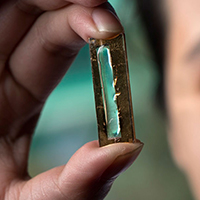
Science Note: Nanowire Battery Breakthrough
/ Alexander MetzgerView the page for this story
Even the best batteries can only be recharged so many times, but scientists have created a new nanowire based system that increases lifespan dramatically. As Alexander Metzger reports in today’s Note on Emerging Science, the key to this game-changing battery is a special coating. (01:55)

Tesla Unveils Novel Solar Roof Tiles
View the page for this story
Elon Musk, the co-founder of Tesla motors, who is pushing a merger with home solar company SolarCity, has unveiled attractive roofing tiles that can capture energy from the sun. Along with a home battery and a Tesla electric car, these could form a complete personal power system, but Spruce Finance CEO Nat Kreamer tells host Steve Curwood that consumers will need to pay a premium for the solar tiles, and it’s not certain shareholders will think the proposed merger is worthwhile. (07:50)

People and the Electric Grid
View the page for this story
America’s aging electrical grid is caught between competing visions for how it should be reformed to cope with a changing climate, changing energy markets and new energy sources. McGill University anthropology professor Gretchen Bakke — author of “The Grid”— explains to host Steve Curwood how she thinks innovators, companies and ordinary citizens can work together to solve modern energy challenges. (15:30)

BirdNote: The Stealthy Shoebill
/ Mary McCannView the page for this story
Deep in the swamps of central Africa lives one of the strangest looking of birds; the Shoebill Stork. The name comes from its huge broad sharp beak, and only about 8000 of these large grey-blue birds survive. As Mary McCann explains, it’s actually related to the pelican, rather than storks. (02:00)
Show Credits and Funders
Show Transcript
HOST: Steve Curwood
GUESTS: Mike Walker, Nat Kreamer, Gretchen Bakke
REPORTERS: Peter Dykstra, Charlotte Rutty, Alexander Metzger, Mary McCann
[THEME]
CURWOOD: From Public Radio International, this is Living on Earth.
[THEME]
CURWOOD: I'm Steve Curwood. Tech entrepreneur Elon Musk unveils a green package to solarize your life, with a big home battery, a powerful electric car and elegant solar roof tiles.
KREAMER: The challenge that we're going to find is, while consumers do like technology bundles that give them more value, especially ones that are good-looking and easy to use, as Tesla and SolarCity have demonstrated they can deliver in other areas, the challenge is going to be, do you want to buy all those things at the same time?
CURWOOD: Also, how to create handy and even attractive alternatives for those plastic bags that usually get thrown away.
FRIED: Part of this project is to build awareness about how much is being thrown away, and how much of what we throw away is completely usable and can replace us buying new things.
CURWOOD: That and more this week, on Living on Earth. Stick around.
[NEWSBREAK MUSIC: Boards Of Canada “Zoetrope” from “In A Beautiful Place Out In The Country” (Warp Records 2000)]
[THEME]
World’s Biggest Marine Reserve Created
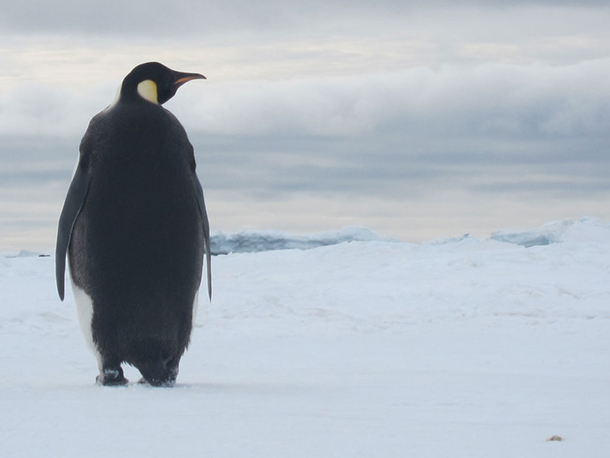
Emperor penguins feed in the Ross Sea. (Photo: Sandwich, Flickr CC BY 2.0)
CURWOOD: From the Jennifer and Ted Stanley Studios at the University of Massachusetts Boston and PRI, this is Living on Earth. I’m Steve Curwood. We begin our program today with remarkable news from the growing movement to protect the oceans of the world. A newly created marine sanctuary off West Antarctica is the largest such reserve in the world, and the first of its kind in international waters. On October 28, the EU and the 24 nations of the Commission for the Conservation of Antarctic Marine Living Resources, known as CCAMLR, agreed to protect some 600,000 square miles of the Ross Sea, perhaps best known for its Emperor penguins. Now, some of the richest and most pristine parts of the Southern Ocean will be out of bounds for fishing and development for the next 35 years. Mike Walker, Program Director for the Antarctic Oceans Alliance, was at the meeting in Australia and joins us now. Mike, thanks for coming on the show.
WALKER: Thanks, Steve. It's good to be here.
CURWOOD: So, I understand that this particular area of the ocean, the Ross Sea, well, has an enormous impact on marine life around the world. What happens there that is just so significant?
WALKER: The Ross Sea is considered to be that of healthiest body of water on the planet. Perhaps people are familiar with the charismatic species that we find down on the Antarctic, of course, penguins, seals, killer whales.
CURWOOD: So, if it's the healthiest part of the ocean, it's the one I guess that has the fewest humans.
WALKER: Yes, that is the case. Human impact has been minimal. There still is some of course, but it has been minimal, and so that's certainly one of the reasons why it is so healthy.
CURWOOD: Now, what's going to happen in terms of what's allowed now on the Ross Sea Protected Area? People fish there...I think they like the Antarctic Toothfish which is sold as the Chilean sea bass. It’s been a pretty lucrative business.
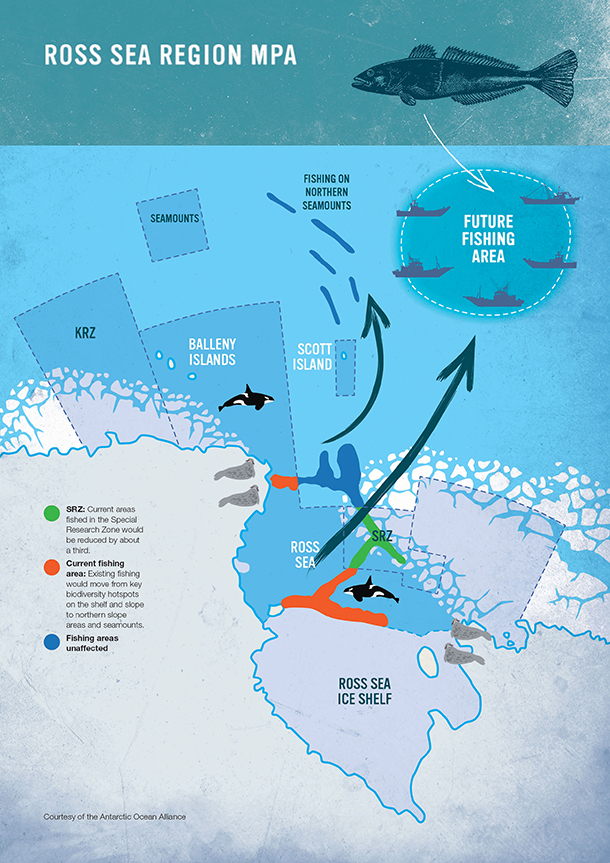
An infographic outlining the changes to fishing regulations in the Ross Sea. (Photo courtesy of the Antarctic Ocean Alliance)
WALKER: Yeah, indeed. Well, of the 1.5 square kilometers has been designated a Marine Protected Area, approximately 1.1 million square kilometers is going to be what's called “fully protected”, so that, quite simply, in two words, means "nothing extracted". But then there are going to be two smaller zones, one just over 100,000 kilometers squared which is going to be a special research zone, which will allow for limited research fishing of krill and as you say the lucrative Toothfish and then an even larger, just over 300,000 kilometers squared will, be for a krill research zone, and allowing for controlled research fishing of krill.
CURWOOD: So how excited are scientists about this development? How important is this?
WALKER: It's hugely important. It's historic in that it is not just the largest marine protected area in the world now, and I very much hope that that accolade doesn't last long and that the future MPAs are put in place which are larger. But it's historic in that it is the first in the high seas, which means the waters outside of any national jurisdiction. And why that is particularly significant and why many, many people are so happy is that being in the southern ocean, being in the healthiest body of water, that will have a great impact on the health of the ocean globally.
CURWOOD: What countries were the most reluctant and why? I imagine that they were concerned about not being able to do certain activities there.
WALKER: Yeah, the Ross Sea Marine Protected Area MPA proposal was made by New Zealand and United States back in 2012, and obviously then it was a matter of winning the support of the other 23 members. Now, when the annual CCAMLR meeting ended in October 2014, there were two countries that were still blocking the proposal. I should say that it's a consensus based system so all the members have to agree. So then when the meeting ended last year, the end of October 2015, in the last 24 hours of the meeting China gave their support to the proposal. So when we started this year, we of course knew there was only one country remaining, Russia. And for the last 12 months there's been considerable discussion and negotiation and outreach towards Russia at various levels.
CURWOOD: What were the Chinese and Russians particularly concerned that they might lose under this agreement?
WALKER: It's hard to know exactly what any one country's interests and motivations are. In the case of China last year, part of winning their support was, and securing their support was, the creation of this krill research zone which actually increased the overall size of the proposal. And then, as I said, in the last 12 months, since the end of the meeting in 2015, there’s been considerable, or there was considerable, negotiation and outreach with Russia. Russia of course has contributed to the process and to the discussions up until then. What we do know is that the negotiation or discussions happened at the highest level. John Kerry made it known in his concluding remarks to the, our ocean conference in Washington back in September, he made it known he had been involved in negotiation with his counterpart Sergey Lavrov on a number of occasions and also had been in discussions with President Vladimir Putin. So that gives a sort of a sense of the intensity, but also the height of the engagements and the political process required to get a decision like this made.
CURWOOD: Now, as you say this is the first major Marine Protected Area on the high seas in the no country's territory. It's also the first that I've seen to be one that has a sunset provision that there's a stipulation that these protections all go "poof" in 35 years if they're not renewed. Why do that? Why not simply make it permanent?
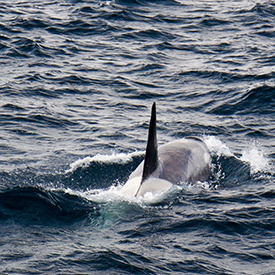
Orcas are among the wildlife that thrives in this newly protected area. (Photo: Ravas51, Flickr CC BY 2.0)
WALKER: Yeah, correct. There is a sunset clause of 35 years which certainly we regret. All the evidence is that Marine Protected Areas are most effective and have the greatest of benefits when they are large and long term. As I just said the negotiations were very difficult, very long. As you point out, it is the first time, and I think there could just be an element of, well, it’s the first time, and so the members and the decision makers involved, there's a degree of caution, and so a 35 year duration is a product of erring on the side of caution.
CURWOOD: To see what happens.
What do you think are the potential impacts of this protected area of the Ross Sea as far as future Marine Protected Areas are concerned?
WALKER: Well, within CCAMLR on the southern ocean there are existing, two other proposals: one for the Weddell Sea and the other for the east Antarctic. They will be considered again, at next year's CCAMLR meeting, so certainly we hope that that last week's decision will create an impetus for additional designations starting with the east Antarctic and the Weddell Sea. We also expect that by the time the CCAMLR meets again next October that there will be a third proposal for the Antarctic peninsula. CCAMLR has committed to putting in place a whole system, so that means up to nine marine protected areas, and so what we hope by last week's decision is that it creates that impetus and also the confidence amongst the 24 countries and the EU, and an appetizer, even, for further designations.
CURWOOD: Of course, one the iconic species there in the Ross Sea is the Emperor penguin, and a few years ago this movie the "March of the Penguins" was quite popular. To what extent do you think people around the world seeing the Emperor penguins struggling to reproduce and survive influenced the decision to move forward with making much of this area marine protected area?
WALKER: Um…I mean clearly penguins are a very charismatic species, one that captures the imagination and has captured the imagination of people for many years. The Russian Patriarch went to visit Antarctica sometime in the last couple of months, and he also I think was famously photographed communing with a penguin. So, yeah, undoubtedly that is something that people get behind, and penguins clearly are something that people latch onto, but there's of course a lot more to the Southern Ocean and Antarctica than just penguins but yes they perhaps a little easier to get people animated about than Toothfish or krill.

The Ross Sea covers about 1.5 million square kilometers off the coast of Antarctica. (Photo: courtesy of the Antarctic Ocean Alliance)
CURWOOD: Mike Walker is the Project Director of The Antarctic Ocean Alliance. Thanks so much for taking the time with us today, Mike.
WALKER: Not at all. Thank you, Steve.
Related links:
- About the Commission for the Conservation of Antarctic Marine Living Resources (CCAMLR):
- The Guardian: “World’s largest marine park created in Ross Sea in Antarctica in landmark deal”
- Official statement from the Antarctic Ocean Alliance on the marine park
- About the Antarctic and Southern Ocean Coalition
- About the Antarctic Ocean Alliance
Beyond The Headlines
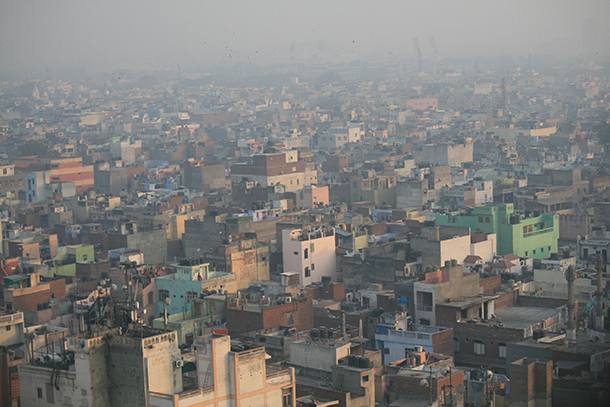
Smog hangs above the tightly-clustered buildings in the southern part of Delhi, India’s capital territory (Photo: Jean-Etienne Minh-Duy Poirrier, Flickr CC BY-SA 2.0)
CURWOOD: Time now to check in Peter Dykstra of DailyClimate.org. and Environmental Health News, that’s EHN.org for what’s going on beyond the headlines. He’s on the line from Conyers, Georgia.
Hi, Peter.
DYKSTRA: Hi Steve. There were two new studies released this past week on the extent of air pollution problems. A study done by physicians in India says that strokes are rising sharply there, projecting that one in six Indians will have a stroke in their lifetimes, and one-third of those stroke victims can blame air pollution.
CURWOOD: Wow. Hey, let’s do some quick math here – so you’re talking about one-third of one-sixth of a nation of a billion people or more – we’re talking, what, tens of millions of potential stroke victims? What’s in the other new study?
DYKSTRA: The other study also focuses on air pollution in the same part of the world: UNICEF, the United Nations Children’s Fund, says that about 300 million children breathe what is considered to be “highly toxic air.” Nearly three-quarters of those kids live in South Asia, where vehicle pollution, factories, naturally-occurring dust, and slash-and-burn agriculture are the leading culprits.
CURWOOD: You know, given everything we hear about China’s pollution, I would have thought it would be at the top of this list.
DYKSTRA: China’s certainly got its problems, but another U.N. agency, the World Health Organization, says kids in South Asian nations including India, Pakistan and Bangladesh, are exposed to air that’s at least six times dirtier than what’s considered safe. They can inherit a lifetime of consequences, ranging from asthma and pneumonia to heart failure, and, as the other study pointed out, strokes.
CURWOOD: And as standards of living rise in these countries, they could either choose to deal with the problem, or make it worse with more and more cars and more dirty energy. What’s next?
DYKSTRA: Let’s talk about oil, and specifically OPEC, the Organization of the Petroleum Exporting Countries, fourteen nations that control close to half the world’s oil supply. Some OPEC nations, particularly Venezuela, are suffering due to two years of low oil prices, and members of the cartel have been talking with non-OPEC oil producers like Russia about tightening oil supplies in order to prop up oil prices.
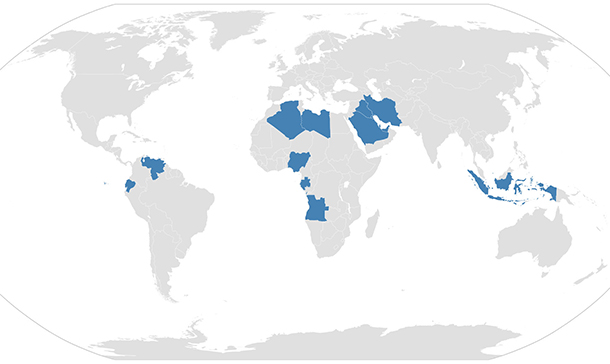
OPEC member countries (Photo: Bourgeois, Wikimedia Commons public domain)
CURWOOD: Which, of course, is not exactly in the spirit of the free market, is it?
DYKSTRA: Bingo. And even if OPEC’s 43-percent share of the world’s oil isn’t quite what it used to be, they still have enormous power to mess with the world’s economy, not to mention its climate. When the OPEC members meet in Vienna at the end of this month, if they’re able to strike a deal to tighten supply, and if they get help from non-OPEC producers, the impacts, good and bad, could be felt everywhere from the gas pump to factories, from trains to trucks to ships. Car buyers might look at more EV’s or hybrids and fewer SUV’s and pickups. The smoky skies of India might be slightly more breathable, and rival forms of energy from coal to solar may see their markets open up a bit.
CURWOOD: Okay, time now for us to turn to the history file, what do you have for us this week?
DYKSTRA: Well, sticking with smoke and oil, twenty-five years ago this week, the world’s worst intentional environmental disaster came to a close as the last of about 700 oil wells set ablaze in Kuwait by the retreating Iraqi army was capped. They had burned for ten months.
CURWOOD: And didn’t Iraq also spill a lot of oil into the Persian Gulf itself?
DYKSTRA: Yes, roughly five to ten million barrels from offshore wells and platforms into the Persian Gulf. The high-end estimates for the Deepwater Horizon spill six years ago are about five million barrels. The land-based oil fires were believed to be an effort by Saddam Hussein’s armies to try and slow or stop forces from the US and its coalition partners from advancing north into Baghdad. Estimates for the land-based oil spill range up to a billion – that’s a billion with a “B” -- barrels burned along with untold volumes of natural gas. And there’s one more, smoky, oily thing about this in a massive act of environmental warfare.
CURWOOD: Oh, what’s that?
DYKSTRA: Disputes with Kuwait over oil were some of the main reasons Saddam Hussein said he’d launched the invasion of Kuwait. He had charged the Kuwaitis with producing more oil than OPEC had authorized.
CURWOOD: Ah, so we have come full circle, and the whole region still suffers, Peter. There are reports that ISIS is now burning oil in trenches in an attempt to hold on to the Iraqi city of Mosul.
DYKSTRA: Right.
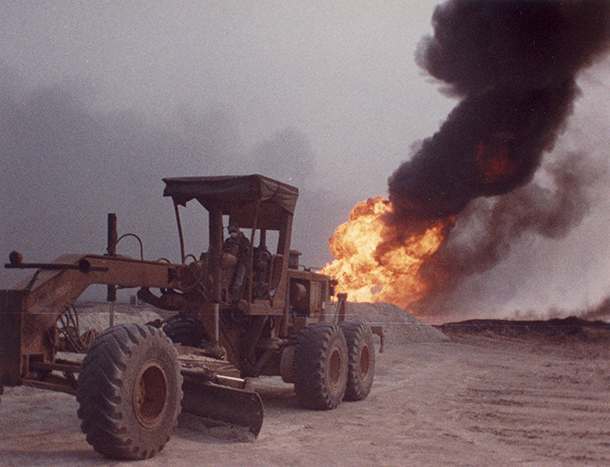
Twenty-five years ago this week, the last of the 700 Kuwait oil wells that had been set ablaze by the retreating Iraqi army was capped. (Photo: Bryan Dorrough, CC BY 2.0)
CURWOOD: Peter Dykstra is with Environmental Health News – that’s EHN dot org – and DailyClimate-dot-org. Thanks Peter, we’ll talk to you again real soon.
DYKSTRA: OK, Steve, thanks a lot, talk to you soon.
CURWOOD: And you can find more information on these stories at our website, LOE dot org.
Related links:
- India air pollution & strokes
- New York Times: “300 Million Children Breathe Highly Toxic Air, Unicef Reports”
- OPEC homepage
- OPEC Nov 30 Meeting
- Size of 1991 Kuwait oil fires
- Size of 1991 Persian Gulf spills
- Size of Deepwater Horizon spill
[MUSIC: Nomadica, “Dance Of the Infidels,” on Dance Of the Infidels, David Buchbinder/traditional, Monkfish Records]
CURWOOD: Coming up...they are classy, convenient and community-building. Bag sharing is next on Living on Earth.
ANNOUNCER: Support for Living on Earth comes from the Gordon and Betty Moore Foundation, and from a friend of Sailors for the Sea, working with boaters to restore ocean health.
[CUTAWAY MUSIC: Marcus Roberts, “A Servant Of the People,” on Blues For the New Millennium, Columbia]
Bag Share
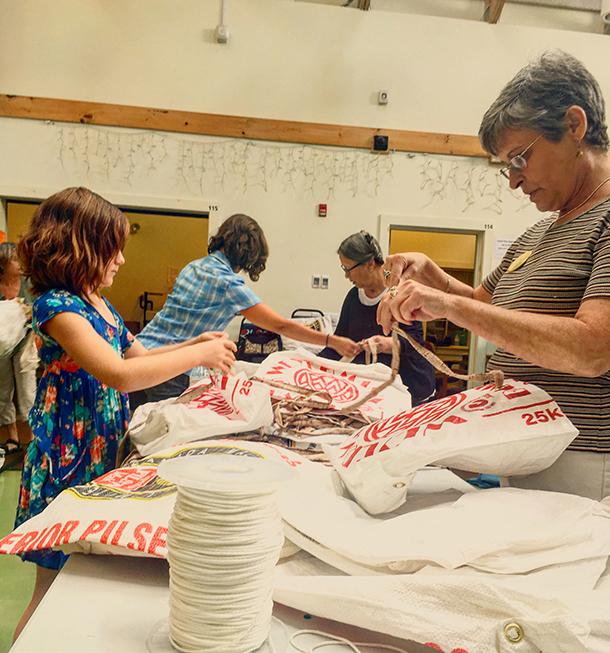
Volunteers affix handles to reusable bags at the Amherst Survival Center. The handles are made from donated scrap fabric, and the bags are malt packaging salvaged from local breweries. (Photo: Mindy Domb)
CURWOOD: It’s Living on Earth, I’m Steve Curwood. Among the issues on the November 8th ballot in California is a referendum aimed at preserving its first-in-the-nation statewide plastic grocery bag ban. California is not alone; several towns around the country also have bans or charge for single-use bags, but Americans still toss about 100 billion of them each year. So, in western Massachusetts, volunteers have come up with a creative and simple solution: sewing, and sharing. Living on Earth’s Charlotte Rutty has our story.
[SOUNDS OF SEWING MACHINES]
RUTTY: In a big, sunny room in Amherst, Massachusetts, 18 volunteers are hard at work. In one corner, a couple of people sort through used animal feed bags and tear out their dirty liners. Beside them, a mother and daughter fold and staple the bags, and then a college student clamps them in place with grommets.
[THUMP OF GROMMETING MACHINE]
[SOUNDS OF RUSTLING BAGS]
RUTTY: The volunteers are all part of a local initiative called the BagShare Project, and by the end of the day the team will have hand-made almost two hundred, recycled, reusable shopping bags.
FRIED: This is just a station for tearing the fabric into the size for the handles…
[SOUND OF TEARING FABRIC]
FRIED: And over there they’re serging the handles and sewing.
[SOUND OF SEWING MACHINE]
RUTTY: Leni Fried is an artist, and she founded the BagShare in nearby Cummington, Massachusetts, back in 2007. Since then, she estimates that volunteers have made about 15,000 bags at community sewing events like this one. They then donate the bags to local stores, where customers can borrow them instead of taking a disposable one.

Leni Fried (right) is an artist and printmaker who founded the BagShare in Cummington, Massachusetts in 2007. Roxy Schneider (left) brought the project to Amherst several years later. (Photo: Mindy Domb)
FRIED: It’s kind of creativity in action. They’re personal. They’re not mass-produced. They’re signed by the sewer, and they’re also really functional.
RUTTY: The bags they make today are for the Amherst Survival Center, where they’ll be used to carry household goods to those in need. But BagShare bags can be found in stores, markets, and libraries all over western Massachusetts. It’s not just that the bags keep their plastic counterparts out of circulation. Since they make use of everything from salvaged fabric and plastic to computer wire, irrigation drip tape, and old clothes, BagShare bags keep all sorts of waste from being sent to the landfill. Leni says it’s important for people to see how a little creativity can save a lot of trash.
FRIED: When you go for a walk and you see a can in the woods…We have to own that trash. And so part of this project is to build awareness about how much is being thrown away and how much of what we throw away is completely usable and can replace us buying new things. If you’re recycling, it’s the end of the line. If you’re reusing, then you can be reducing what you buy and replacing something new.
RUTTY: The BagShare certainly fills a local need: in May 2016, Amherst passed a law barring stores from distributing the single-use plastic bags. Today’s bag-making is part of a flurry of activity to get more reusables into circulation by the time that ban takes effect in January.
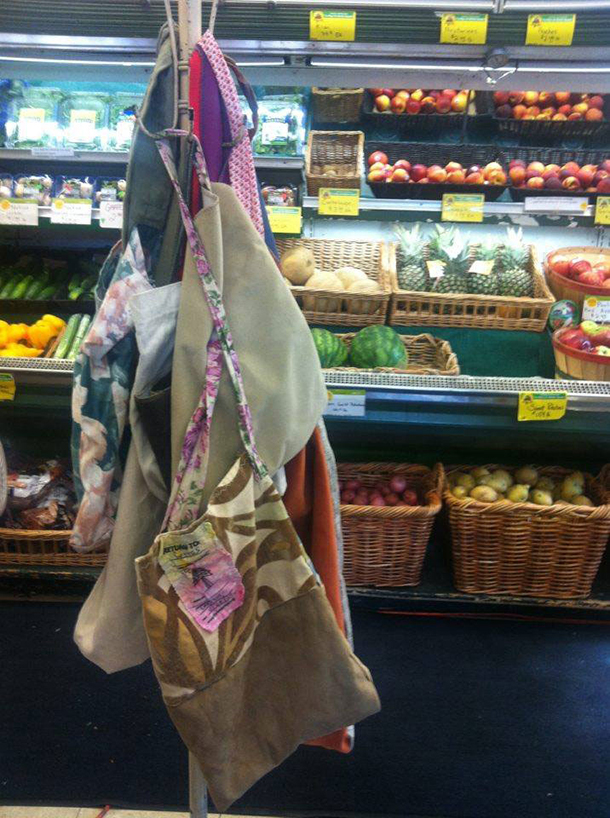
At Serio’s Market in Northampton, customers can borrow a BagShare bag if they haven’t brought their own reusable. The handmade bags can be found at stores, markets, and libraries all over western Massachusetts. (Photo: Charlotte Rutty)
In nearby Northampton, plastic bags have been banned for almost a year. The ban has helped reduce waste, but it doesn’t stop stores from using disposable paper bags. BagShare does.
[SOUND OF GROCERY STORE CHECKOUT]
Jaimie Golec runs Serio’s Market, a family grocery store in Northampton. It was one of the first stores to offer its customers the handmade bags. Since then, Jaimie says, she’s really seen a difference.
GOLEC: The amount of paper bags we have to order has reduced dramatically. Probably half.
RUTTY: BagShare bags hang on hooks at the entrance and exit of the store. They’re free to anyone who hasn’t brought their own reusable. As customer Andrew Stein loads his groceries into one of the bags, I ask him what he thinks of them.
STEIN: I thought it was a great idea. They look cool. They’re obviously repurposed from all sorts of different materials… So, yeah, and there’s a necktie as the strap and this kind of thing.
RUTTY: Serio’s customers have responded positively to the idea. They’ve even started donating scrap fabric to the project. As we leave the store, Jaimie passes us a few weeks’ worth of donations in huge bags. It’s a lot of fabric.
SCHNEIDER: This goes in your car.
FRIED: Look at all this! It’s unbelievable, right? OK.! It just keeps going, right? We can’t stop it, Jaimie!
[SOUND OF WALKING AND DROPPING BAGS OF FABRIC]
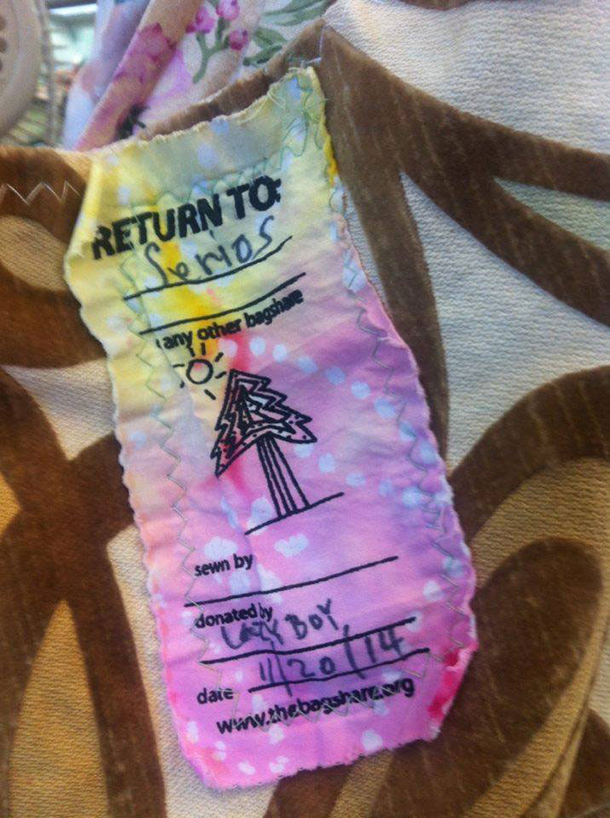
Leni Fried estimates that since 2007, BagShare volunteers have put up to 15,000 recycled, reusable bags into circulation. (Photo: Charlotte Rutty)
RUTTY: People all over western Massachusetts have donated scrap materials and sewing machines. BagShares have sprung up in nine different towns in the area.
FRIED: It’s not a top-down organization. I may have somebody contact me and all I do is just say, “OK, great. Where do you live? Who can you sew with? Who can use these bags?” I kind of help give them a direction, but then they lead. So my job is sort of creating leadership.
RUTTY: One of those leaders is Roxy Schneider, the volunteer who brought BagShare to Amherst several years ago, after stumbling across a sewing event in nearby East Hampton. She’s sewn all her life an, in addition to BagShare sewing sessions, she offers clothing repair clinics at the Amherst Survival Center.
SCHNEIDER: People can come, their kids can come, and learn how to sew. Elders can teach them. Men are learning how to sew buttons for the first time.
[SEWING MACHINE]
RUTTY: Teaching is central to the BagShare Project, especially teaching skills that go unappreciated in a world where most of what we need can be bought in a store. Here’s Leni Fried again.
FRIED: I call it a “maker-based activity,” compared to a “meeting-based activity.” I think that in our culture we’re too oriented often to do things with our heads rather than our hands. And so the more we can teach these kinds of skills, I think, the better off we are, we’re more prepared for whatever may happen in the future.
RUTTY: Being prepared is useful, but Leni says it’s the community around BagShare that is the real measure of its success.
FRIEND: We, as Americans, a big part of our identity is often that we’re individuals. And so the BagShare is about shifting that because we only have one planet, and we are forced to share it whether we want to or not. And I think that also, by sharing, we’re less alone. And I think that’s why the BagShare keeps going.
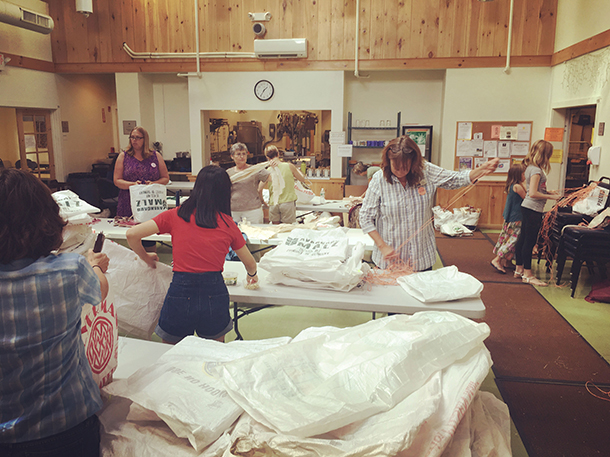
BagShare volunteers assemble reusable bags station by station. The initiative attracts sewers and non-sewers of all ages. (Photo: Mindy Domb)
RUTTY: Going, and growing. Similar initiatives now exist as far away as Australia and Cambodia. For Living on Earth, I’m Charlotte Rutty in Amherst, Massachusetts.
Related links:
- The BagShare Project
- How to make one of Leni’s Seed, Feed, and Malt Bags
- The Amherst Survival Center
[MUSIC: David Wax Museum, “Colas,” on Carpenter Bird, based on traditional Mexican son jarocho songs, self-published]
Science Note: Nanowire Battery Breakthrough
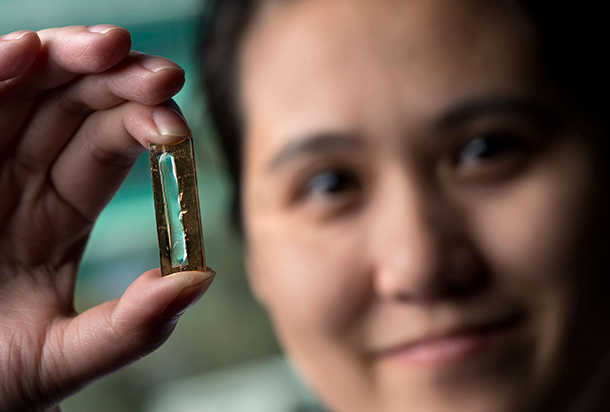
UC Irvine doctoral candidate Mya Le Thai displays her experimental nanowire technology that could dramatically increase the lifespan of rechargeable lithium-ion batteries. (Photo: Steve Zylius, University of California Irvine)
CURWOOD: In a minute, designer-friendly solar energy roof tiles, but first this note on emerging science from Alexander Metzger.
[SCIENCE NOTE THEME]
METZGER: From cell phones to laptops to cars, batteries power many of our everyday conveniences. As these devices become increasingly important, so does the lifespan of the batteries powering them. The popular lithium-ion battery, for example, survives only a few thousand charges at most. So researchers at the University of California, Irvine have developed a technology using nanowires that could increases battery life hundreds of times.
Because Nanowires are about a thousand times thinner than a human hair, bundling them together creates a huge surface area in a tiny volume. This translates to a greater capacity to store and conduct electricity than conventional wires. But there’s a snag: Nanowires quickly degrade when electricity passes through them, a problem that scientists have been working on for decades.
This breakthrough involves using gold nanowires coated in a manganese dioxide shell, and totally encased in an electrolyte gel. This makes wires flexible and resistant to cracking and enables hundreds of thousands of charging cycles with almost no damage to the wires themselves. While gold nanowires could become expensive if used in bulk, the researchers suggest that the same technique could work with cheaper, more common metals.
Scientists believe this technology could revolutionize how we power everything, from smart phones to spacecraft. While it may be many years before these next-generation batteries are on the market, this microscopic breakthrough has the potential to bring about some very big changes.
That’s this week’s note on emerging science, I’m Alexander Metzger.
[SCIENCE NOTE THEME]
Related links:
- Read the research paper: “100k Cycles and Beyond: Extraordinary Cycle Stability for MnO2 Nanowires Imparted by a Gel Electrolyte”
- University of California Irvine News: “All Powered Up”
- Los Angeles Times: “UCI researchers’ invention could lead to longer-lasting batteries”
Tesla Unveils Novel Solar Roof Tiles

Tesla’s new solar roof material. From left: Tuscan Glass Tile, Slate Glass Tile, Textured Glass Tile, and Smooth Glass Tile. (Photo: Tesla Motors)
CURWOOD: Elon Musk is one of those entrepreneurs who’s always trying, and often managing, to create game-changing innovations. A rich man, thanks to his part in building Paypal, he’s the brains behind Tesla electric cars and SpaceX, the private company already delivering cargo to the International Space Station. And in a bid to create one stop shopping for home and mobile energy, he is pushing a merger of two companies where he is the largest shareholder: Tesla and the home solar company SolarCity. Incidentally, SolarCity is an underwriter of Living on Earth, but has no editorial input. And Elon Musk is also pointing to another potential technological breakthrough: Solar roof tiles, which he says are about as efficient as regular panels but look just like a normal roof. We called up Nat Kreamer, CEO of Spruce Finance, and Chairman of the National Solar Energy Industries Association, for his take on this new venture. Nat, welcome back to Living on Earth.
KREAMER: Thank you for having me.
CURWOOD: First, what do these Tesla solar tiles look like, and how do they work?
KREAMER: Well, the tiles from the pictures that I have seen look like slate roof and terracotta and regular asphalt shingles which really match the kinds of roofs that customers have in the markets where solar is economically attractive, and clearly these are very attractive to put on your home, and they work very similarly to a regular PV panel that you might install or you're used to seeing.
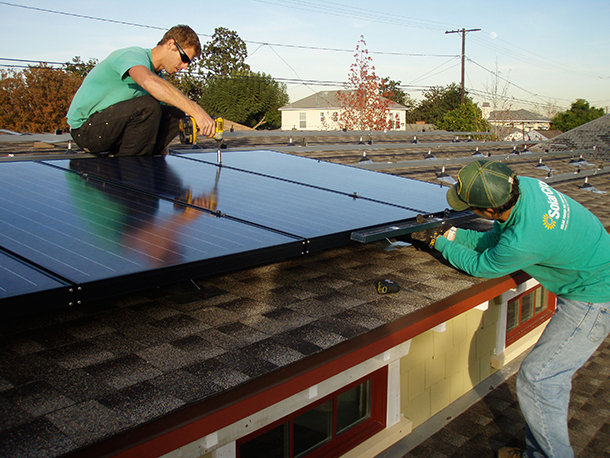
SolarCity employees install traditional solar panels on a Los Angeles home (Photo: Steve & Michelle Gerdes, Flickr CC BY-NC-ND 2.0)
CURWOOD: So, the advantage here to using regular solar roofing material is that it doesn't look great?
KREAMER: Well, I think you're one of the challenges that we find among a certain set of consumers as they look at solar panels, and the best place to put the solar panels on their houses in a location where, frankly, doesn't look very good, and the benefit of the Tesla solar roofing is that you really can't tell the difference, and it really, I think, opens up a segment of the market to consumers who are both image conscious, thinking about what their home looks like, but also really looking save money with clean affordable solar power.
CURWOOD: Speaking of saving money, I mean, how hard on the wallet are these solar tiles going to be compared to the conventional PVs that it seems that the Chinese are making ever cheaper and cheaper?
KREAMER: I think what you've seen in last 10 years in the US solar industry is we've been able to cut costs by more than 70-percent, and today solar power globally is the lowest-cost form of energy. These tiles, I think, will be able to command a premium because they're better looking just like the same way the people pay more for technology that's got a great aesthetic. You can see that with Apple.
The question will be is how much of a premium will consumers be willing to pay for these tiles versus a standard PV, and I think that really depends on what the consumers buying motivation is. We do know that historically SunPower has produced really good looking panels and was able to extract a premium for those. So I think that people will pay more for them, but I don't think you're going to see them pay so much more that they’ll pay more for solar power than they would for their regular electricity.
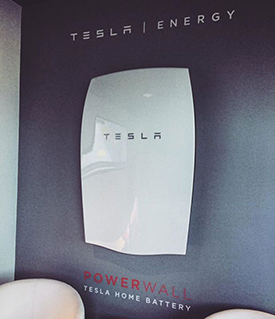
The Tesla PowerWall (Photo: Pasco Olivier, Flickr CC BY 2.0)
CURWOOD: Now, how economical might this solar roofing technology be for commercial buildings as well as residences?
KREAMER: I don't think you would want to use an aesthetics technology in a commercial environment. Frankly, most commercial environments have flat roofs, they're often obscured so that there's a façade in front of them that the consumer or customers who are walking into a storefront can't see the actual roofing. So, in that instance the look of the solar panel really doesn't make any difference. What really makes a difference is the quality and the efficiency and that the installation of that system and really the price of power in a commercial setting.
CURWOOD: Now solar roof tiles are just part of the Elon Musk vision. He's had this power wall which is storage for solar and I gather he's upping the ante there now, huh?
KREAMER: I think so. I think we're seeing in the storage market, start-up companies, Tesla, and then many, very large, global power, electronic manufacturers offer storage solutions. So, for example, the most robust market for residential energy storage today is Australia, and the reason for that is two-fold. Number one is over 10-percent of all homeowners in Australia have residential solar on their roof. And, two, the local utility in Australia increased the price to connect to the grid to such a level that residential storage became more cost-effective than being connected to the grid. And so what you're seeing is tens of thousands of homeowners order residential storage in the Australian market. There are many companies that are supplying that market and they include names like Panasonic, and I think you're going to see that it's a very competitive market for storage globally and that we as US consumers will benefit, really from the cost declines of that competition here and see storage become economical much sooner than I think a lot of people thought.
CURWOOD: Talk to me, Nat, about Elon Musk's drive now to merge Tesla and SolarCity.
KREAMER: I think fundamentally that the Tesla and SolarCity merger, as far as I can tell, really is bringing together a lifetime value solution which is,“Let me bring more value to you as a consumer in the way you consume energy, the way you produce energy, and the way you get transportation, and let me give you a complete bundle and a complete experience in your home. And if I can give that to you, I can bring more value to you as a consumer, on one hand, and, two, I can capture more value from you as a company.” And I think that's core to the Tesla-SolarCity merger.
I think the really big open question for me is, is now the right time and do two companies need to be merged or can they be in partnership? And I think that clearly the teams at Tesla and SolarCity have made their decision, but I see other people pursuing a similar business model and doing it in partnership as opposed to via acquisition.
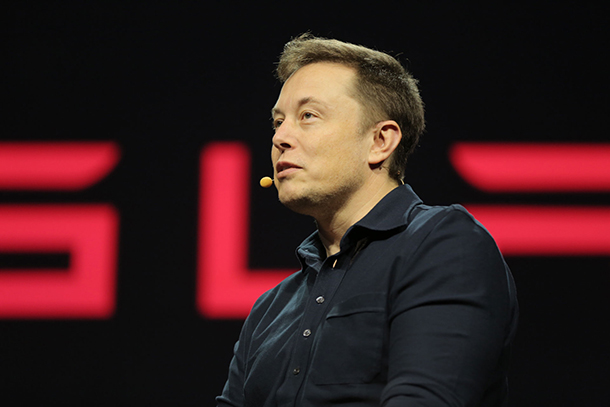
Elon Musk (Photo: NVIDIA Corporation, Flickr CC BY-NC-ND 2.0)
CURWOOD: So, these solar roof tiles are part of the vision, there, of Elon Musk and Tesla - SolarCity, a vision to market electric cars with the power wall home battery, and home solar energy production all together. Where you think Tesla is at right now in terms being able to deliver on that vision? In other words, where is it going to be available?
KREAMER: Well, I know that today you can buy a Tesla, and you can buy a Power Wall, and you can buy solar directly from SolarCity. I think we'll get more details on the exact availability of the roof tiles to the broad market. I think the challenge we'll find is while consumers do like technology bundles that give them more value, especially ones that are good-looking and easy to use as Tesla and SolarCity have demonstrated they can deliver in other areas, the challenge is going to be, do you want to buy all those things at the same time.
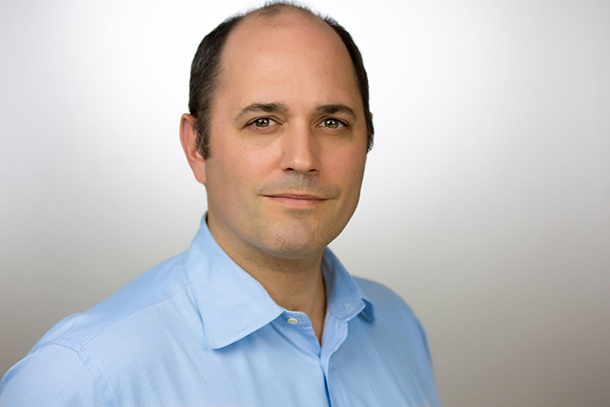
Nat Kreamer is the President and CEO of Spruce Finance, a solar energy financing company. (Photo: Spruce Finance)
And one of the challenges that the residential solar industry has had is that the cost of customer acquisition is quite high, and one way to address that is sell more when you sell a customer one product. And I think that the open question will be, do you buy solar tiles and replace your roof when you chose to go solar? Will you go solar when you decide to buy a car? If you bought a car and a roof will you then buy solar later? It's really about consumer buying behavior and whether or not consumers will buy bundles at the same time, I think, is an open question, frankly, for the residential solar market in general but specifically for the Tesla-SolarCity vision.
CURWOOD: Nat Kreamer is the President and CEO of Spruce Finance, and chairs the Board of Directors for the National Solar Energy Industries Association. Matt, always a pleasure to talk to you and I imagine as solar advances, we'll be talking to you again soon.
KREAMER: Likewise, thank you so much again today.
Related links:
- Tesla’s new solar tiles
- CNBC: “Tesla and SolarCity executives aim to quell naysayers before vote”
- Bloomberg: “No One Saw Tesla’s Solar Roof Coming”
- Listen to Living on Earth’s previous interview with Nat Kreamer
- Spruce provides financing for residential solar
[MUSIC: Tim O’Brien, “The Foggy, Foggy Dew,” on Cornbread Nation, English traditional/arr.Tim O’Brien, Sugar Hill Records/Howdy Sides Records]
CURWOOD: Coming up, getting power to the people...an anthropologist on the human side of the electricity grid. That’s just ahead here on Living on Earth. Stay tuned.
ANNOUNCER: Funding for Living on Earth comes from you, our listeners, and United Technologies - combining passion for science with engineering to create solutions designed for sustainability in the aerospace, food refrigeration, and building industries. UTC companies such as Otis, Carrier, Pratt & Whitney and UTC Aerospace Systems are helping to move the world forward.
This is PRI, Public Radio International.
[CUTAWAY MUSIC: Ruben Gonzales (et al), “Date Una Vueltecita,” on Momentos, Jorge Mazon, Cuban Essentials/Escondida Music]
People and the Electric Grid
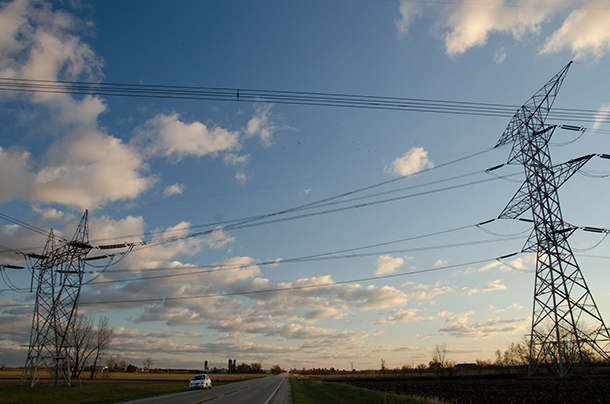
Electric Electric power transmission in the United States consists of three grid systems known as the Eastern, Western and Texas Interconnections. (Photo: Michael Kappel, Flickr CC BY-NC 2.0)
CURWOOD: It’s Living on Earth, I’m Steve Curwood.
With the flip of a switch, when evening comes light can flood our homes here in America. It seems so easy. But the electric grid is far from effortless for those on the frontlines of maintaining it. Behind the low of hum of kitchen appliances is a system that’s grown unwieldy, expensive to manage, and hard to integrate with new forms of energy generation and business models. Anthropologist Gretchen Bakke has written a book entitled "The Grid" that reveals how the electric grid’s intricate hardware has become entwined in a network of competing human interests. Gretchen Bakke joins us now on the line from McGill University in Montreal, where she teaches. Welcome to Living On Earth.
BAKKE: Thank you for having me.
CURWOOD: So I have to say this is the first book I've read about electricity by an anthropologist. What got you interested in the electric grid?
BAKKE: I think it is unusual for an anthropologist to study something as complicated and ubiquitous or every day as the electrical system, but one of the things that I discovered after doing research in Eastern Europe for several years, when I came back to visit my parents who live in rural Oregon, is that their grid was going down a lot. They were having a lot more blackouts than they’d ever had before, and that's where I really started to see that there's a way in which every day, regular people are interacting with this giant infrastructure in ways that they had been before, that there was a kind of letting go of this assumption that the state would do it, or that the utility would do it, and taking that on themselves.
CURWOOD: So, what's really interesting is that if someone is listening to us on the radio now that is plugged in, that radio is plugged into the grid, they're hearing us at the very same time that the signal is being sent from this recording. And the power that they have has all come at that same instance as the other people around the country who are in the same grid, and so you really can't store it as electricity.
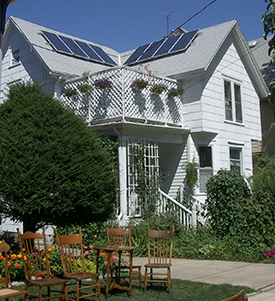
Although homeowners are increasingly turning to small solar systems for their energy, the variable nature of solar and other kinds of renewable energy creates complications for the grid. (Photo: Jascha Jabes Flickr CC BY-NC-ND 2.0)
BAKKE: You can't store it at a scale that's significant enough to make a difference to the grid because the grid is very, very big. We know we can store it in small amounts. We have batteries in our telephones, for example, and our computers, but it's difficult to engineer perfectly that kind of storage device for a grid that is half-national in size. Because we have, in the US we have three of them. We have one for the whole West. We have one for the whole East, and Texas has its own. So we have these three huge grids with thousands of power plants that are working in sync on each side.
CURWOOD: What do you see as the grid's biggest weaknesses?
BAKKE: There are several. The classic one is simply that is old. It was built and designed for the 20th century, and a lot of the power plants that we’re still using are from the 1950s, 1960s, 1970s, and many of those are being retired now. So, nuclear power plants are being retired. Coal-burning power plants are being retired, and they're being replaced with natural gas, wind power, and solar. So 97-percent of the new electrical generation that came online in 2015 was one of those three, and wind actually outpaced natural gas.
CURWOOD: And why does that make a problem for the grid?
BAKKE: Because it's an infrastructure that it's not quite like the other infrastructures we're used to, and the grid we made throughout the 20th century was designed to allow people to use as much electricity as they wanted, whenever they wanted, for a very fair price, but the way that that functioned with the grid is that we controlled how much...All of the control was on the side of how much power we made. So people could use much as they wanted, but on the production side that would be matched, by just turning a power plant up, for example.
And what's happened with renewables is that now, if you have wind power, the wind blows. And how fast the wind blows or when the wind blows determines how much electricity is going into the grid. So, you have this variability on the production side, and you also have a variability, still, on the use side, which is us. And so, suddenly, instead of trying to balance one thing you're balancing two things which don't necessarily jive with one another, and that's just far more complicated.
CURWOOD: And I have to ask you, why our power outages becoming more and more common? You begin your book with a series of outages. You say that, you know, the average American will, what? Put up with as much as six hours a year; whereas, somebody in Japan might only have 15 minutes a year?
BAKKE: Yeah, exactly. And you know it. These outages happen all the time, and some of them are quite short, but they’re a very common part of American life in a way that they aren't in the rest of industrialized world.
Part of it has to with the fact that now you can make a profit on electricity, so electricity gets bought cheaply and sold dearly and shipped across the system in ways that the lines simply weren't made for. And this is this misunderstanding of electricity being like a car, right? Like that it doesn't matter where you get it, and where you use it. You just sort of move it on the infrastructure, and it's all the same. But power lines become less efficient, the further you send the electricity, so you start to have these sort of weird harmonic resonances and dissipation of electricity off of power lines simply because the structure of how profit is now made, after the age of the internet, is different with the power system.
CURWOOD: So, in the old system there was profit, but it was set at a particular level, and there was no way for speculators and folks on Wall Street, really, to make a big buck. Today now we've open the door, huh?
BAKKE: Yeah, absolutely we treat electricity like any other commodity.
CURWOOD: But it's not, is it? I mean, like you write your book, you can't really store large quantities of it. Here you use it or you lose it.
BAKKE: Yes, you use it or it destroys the system. (LAUGHS.) That's the thing. It's like, you can't...you don't make it, you have to not make it because having too much on the wires is as bad for the system as having too little on the wires.
CURWOOD: So you're saying we have this disconnect between how folks looking to make money on speculation and margins are pushing a system that wasn't at all really designed to do that.
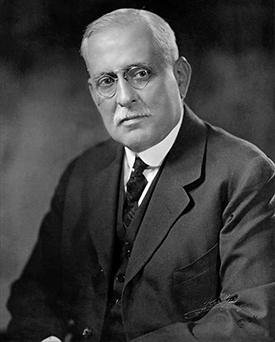
Samuel Insull played a key role in the creation of America’s integrated electric infrastructure during the Industrial Age. (Photo: William L. Koehne Studio, Chicago (Print magazine) [Public domain], via Wikimedia Commons)
BAKKE: Exactly, exactly. And one of the things I discovered when I went into this book is, I thought I was writing a book about technology and people and sort of the social culture of origins of a technological system, and what a lot of the book is, is in fact a business history.
CURWOOD: So, tell me the story now.
BAKKE: Yeah, I think what is one of the most fascinating things is that we think of a mass market as being something that America always had, that there was this idea that you could sell things to everybody at a low price and make money off of them, and that that was not the story. In fact, as electricity became something that was changing from a thing for the rich into a thing for everybody, the sale of things like an iron you can plug-in, it came with electricity. So electricity was one of the first place that there was this idea that you could make money selling a little bit of something to a lot of people. And the way that happened was that originally it was really only an elite…It was only for elites and for factories, and that part of that is because grids were quite small in the beginning. We used what is called direct current, and direct current doesn't go very far, and it has to be produced at the voltage which is used, which sounds complicated but it just means that if you are a streetcar company you are not going to produce the same voltage at the power plant that somebody who just needs a lighting system is going to have.
And then things began to change, and we adopted alternating current, and the grids got bigger. And, as they got bigger, the economics of inclusion started to shift, so that any place that was dense - so urban centers - could start to bring people into a larger, public grid. And then after the Great Depression Roosevelt came in and said, “Look, everybody needs electricity. This is something that everybody needs like potable water.” It becomes part of a program of national uplift, and he gets the federal government to fund the extension of wires out to rural areas, poor areas that utilities never would've reached otherwise because they simply couldn't make any money off of them.
CURWOOD: Your write about government's involvement with electricity, bringing it to every home but not just in the sense of electrifying, but in the business model.
BAKKE: Yeah, absolutely. So, the problem with electricity is that the greatest cost with the old model, the greatest cost for the utilities was actually the interest on the loans for the power plants. And because of this they needed really low-interest rate, guaranteed loans, and so they began to talk.
One particular innovator, Samuel Insull in Chicago, began to talk to government about regulating the industry. He wanted to be regulated. So we can think of industries not wanting to be regulated or fighting regulation, but, in fact, Insull, he wanted to be regulated, not by politicians because politicians were...They were an iffy bet in the 1910s and 20s, so Samuel Insull and progressive politics kind of came together to create a bureaucracy of regulation that allowed the utilities to function as what were called natural monopolies, and this is why still in most places in the US there is no competition within the domain of a utility. You don't have a choice if you pay your bill to Pepco or someone else. You have to pay the bill to whoever it is rules your area. But, unlike a regular monopoly, they were not allowed to set the prices however they wanted, and that's because they were regulated by government. So government, actually, legislatures in some cases or regulatory bodies, still sets the price of electricity within any particular region.
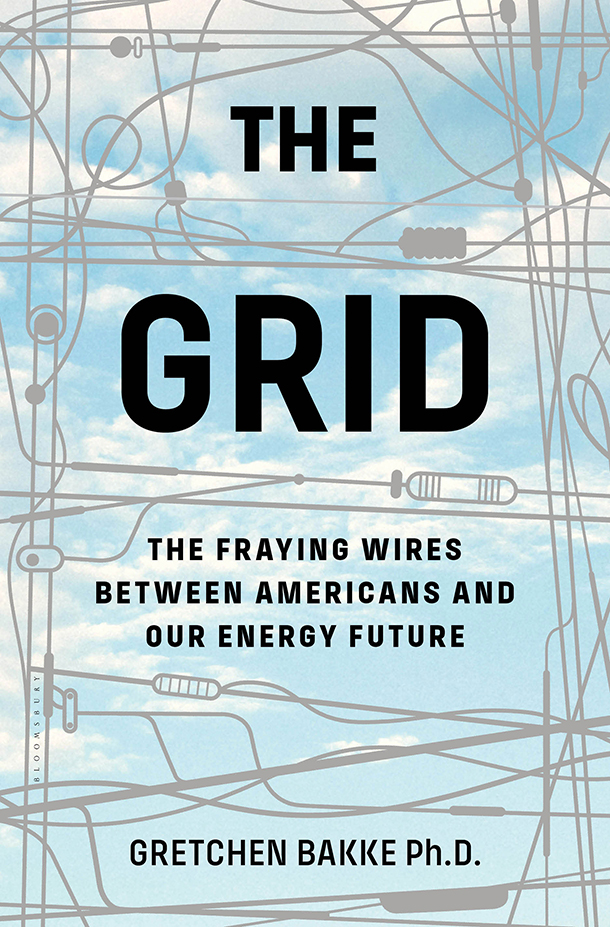
The Grid evaluates the future of America’s electrical grid from an anthropological perspective. (Photo: Sara Mercurio)
CURWOOD: Now, in your book you write about a turning point, perhaps, a vote in Congress that passes with just one vote in the House that declares that utilities must buy energy from small energy providers. This is PURPA. This is the Public Utilities Regulatory Policies Act. So, tell me how this law passed, and the Jimmy Carter era began to break down the monopolistic energy grid that we inherited from the industrial age.
BAKKE: Well, Jimmy Carter was elected on a platform of energy reform, and he did many many things with this act, fuel efficiency in cars, ecetera, etcetera, etcetera. And one teeny, tiny piece of this was to require utilities essentially not to be monopsonies, which is a funny word that we don't use very much. But he said it's fine if they are still monopolies. They can have their...They can control their land. But what this act did, is it said no utilities for these tiny, tiny amounts of electricity. You have to buy it, and you have to buy it at a reasonable rate. You have to buy it at the rate it would cost you to make it, and it opened the door to, just kind of on a whim, it feels like, it opened the door to what was called “unconventional generation.”
And that meant tiny little hydroelectric dams were going, went all over California. Wind turbines which were a very, very unproven technology at that time, like, many of them didn't work at all or didn't work for very long, but, nevertheless, the people building wind turbines or putting together solar powered systems, they had the right to sell their electricity to the utilities, and utilities had to buy it and had to move it to market.
And people get very excited about it. It was small in the beginning, but it grew and grew and grew and grew and grew. Even Wall Street started to invest in these systems. And in the 1980s, which we tend to think of the Reagan years as this sort moment of decadence and excess and nothing really interesting going on on the greener side of things, this was actually when PURPA came to life. So it wasn't percolating up into the media or into popular consciousness, but wind farms were going in. Strange little things were being built. So it was the 80s sort of under the wire - Excuse the pun - where the time at which the revolution that we now are in the midst of, really got feet.
CURWOOD: So, how resilient is America's grid to natural disasters like, well, that huge storm out on the west coast known as the Great Gale or Superstorm Sandy?
BAKKE: It's not resilient to natural disasters. We can't really create an infrastructure that will never go down, but what we can create an infrastructure that we can fix more quickly. And I think that's what a lot of people are after is, yes, it goes down, but it only goes down for a couple of hours. It doesn't go down for a week.
And this is where the micro grids start to come in. So, a micro grid is...It's a system that has more than one form of generation, and it also has to have more than one meter or more than one customer. So it's essentially just like the big grid but on a much, much smaller scale. If New Jersey Transit System, for example, which runs train lines all throughout New Jersey but in and out of Manhattan as well, if they can make that micro grid work, not only do the trains work but every single train station becomes the place, becomes a warming center, becomes a place where people can charge the phones. To have these sort of pockets of warmth and light and power is a first step, and those systems are not isolated from the grid all the time. They can just work when the rest of the grade goes down.
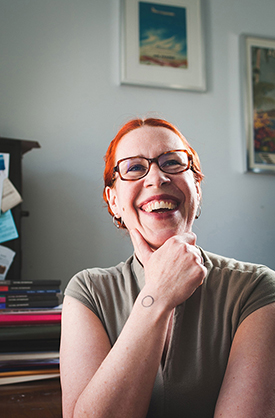
Gretchen Bakke is an Anthropology professor at McGill University. (Photo: Alex Tran)
CURWOOD: So, what do you make of the research done by some folks at NOAA, saying that in 15 years we could have 80 percent renewables, if the grid were all connected with high voltage DC, so we can have a true national grid?
BAKKE: Right. So this is...That's a wonderful plan. This is sort of where the anthropology piece of it comes in because it's great. They're right, hands down, but how do you build those wires? People don't want the wires in their backyard anymore. Nobody wants any more wires to go in. So what do people like? People like solar. People like small solar systems. OK, then you get somebody like Elon Musk who comes along and says, “Well, if people like to make small amounts of electricity, let's let them store small amounts of electricity.”
So, then there is this other competing dream, and I think that's one of the things that really differentiates the way that the US is dealing with the transition to renewables versus Europe, because in Europe very often there will be a plan from on high that says, “This is how we're going to manage it.” It doesn't mean it works perfectly, but there's a plan. And in the US you can have a plan, but how do you instrumentalize that plan? And I think that's the big question with the NOAA proposal. It doesn't mean it is a bad plan at all. You still have to make it happen. You have to get it funded. People have to let you on to their back-40, so how do you overcome that?
My suggestion is that you think about, or pay attention to, sort of the patterns of what people do actually like to do, what they do put their money toward, what they are attentive toward, and figure out how to build up from that. Also, from the people who are trying to make money off of it. So there's sort of the dreamers and there's the capitalists, and there's the planners, and there's the regulatory bodies. And the question is, how do you string these people, or tie these people, together? And of course, that's always the American question, right? The grid is no different in this regard. It's always the American question. But I think that with our eye on the prize, it can actually be done.
CURWOOD: Gretchen Bakke's book is called "The Grid: The Fraying Wires Between Americans and Our Energy Future". Thank you so much for taking the time with us.
BAKKE: Thank you.
Related links:
- The Grid: The Fraying Wires Between Americans and Our Energy Future
- Gretchen Bakke’s academic profile
- Modern power outage data
- More on micro-grids
BirdNote: The Stealthy Shoebill
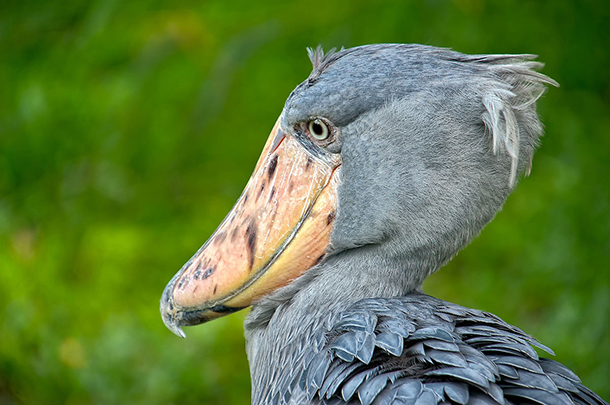
The African Shoebill. (Photo: Paul W. Sharpe)
BirdNote®
[BIRDNOTE THEME]
CURWOOD: Birds come in all shapes and sizes, with feathers drab or colorful, and voices melodious or grating. And periodically, as Mary McCann points out in today's BirdNote®, there are birds that are, well, downright weird.
[SFX}
MCCANN: Deep in the dense, remote swamps of Central Africa lives one of the most peculiar looking of all birds. Picture a massive, blue-gray stork, standing up to five feet tall on long, gray legs. But instead of the stork’s long, tapered bill, substitute a prodigious, stout bill that’s hooked at the tip — and that gives this bird its name.
[Shoebill bill clapping and vocal sounds, http://macaulaylibrary.org/audio/2285, 0.48-54]
Meet the Shoebill, a bird unknown to science until the 19th Century, and the only living member of its family. So named because that comically large bill is, yellow-orange, and shaped like an oversized Dutch wooden shoe. But although the Shoebill looks like it walked right out of a cartoon, its beak is no joke. The edges are sharp enough to behead its prey, which include catfish with hard bony heads as well as lungfish, snakes, and even baby crocodiles. Which Shoebills hunt in the shallows, often standing completely motionless before they strike.
The Shoebill’s physical resemblance to the stork gave it its early name, the Whale-headed Stork. But DNA analysis showed that it’s more closely related to pelicans — another group of birds whose oversized beaks are truly awe-inspiring. Shoebills are notably less numerous than pelicans, though, with only 8,000 surviving in the wild.

Shoebills resemble storks, but are more closely related to pelicans. (Photo: David Cook)
I’m Mary McCann.
###
Written by Bob Sundstrom
Bird sounds provided by The Macaulay Library of Natural Sounds at the Cornell Lab of Ornithology, Ithaca, New York. [2285] recorded by Marian P. McChesney.
XC320901 ambient sounds recorded by James Bradley, Kenyan Swamp setting.
BirdNote’s theme music was composed and played by Nancy Rumbel and John Kessler.
Producer: John Kessler
Executive Producer: Sallie Bodie
© 2016 Tune In to Nature.org November 2016 Narrator: Mary McCann
CURWOOD: Swoop on over to our website, LOE.org for some pictures
Related links:
- This story on the BirdNote website
- About the Shoebill from the National Audubon Society
- Happy shoebill saved from poachers
[MUSIC: Marcus Roberts, “It’s Maria’s Dance,” on Blues For the New Millennium, Columbia]
CURWOOD: Living on Earth is produced by the World Media Foundation. Our crew includes Naomi Arenberg, Bobby Bascomb, Aidan Connelly, Savannah Christiansen, Jenni Doering, Jaime Kaiser, Don Lyman, Alex Metzger, Helen Palmer, Adelaide Chen, Jennifer Marquis, and Jolanda Omari. And we’re sad to bid farewell today to a hard-working member of the team, Emmett Fitzgerald. Emmett, we'll really miss your dedication and sense of humor, but we wish you all the best!
Tom Tiger engineered our show, with help from John Jessoe, Jake Rego and Noel Flatt. Alison Lirish Dean composed our themes. And you can hear us anytime at LOE.org - and like us, please, on our Facebook page - PRI’s Living on Earth. And we tweet from @LivingonEarth. I'm Steve Curwood. Thanks for listening.
ANNOUNCER1: Funding for Living on Earth comes you, our listeners, and from the University of Massachusetts, Boston, in association with its School for the Environment, developing the next generation of environmental leaders. And from the Grantham Foundation for the protection of the environment, supporting strategic communications and collaboration in solving the world’s most pressing environmental problems. Support also comes from the Energy Foundation, serving the public interest by helping to build a strong, clean, energy economy, from Gilman Ordway, and from SolarCity, America’s solar power provider. SolarCity is dedicated to revolutionizing the way energy is delivered by giving customers a renewable alternative to fossil fuels. Information at 888-997-1703. That’s 888-997-1703.
ANNOUNCER2: PRI. Public Radio International.
Living on Earth wants to hear from you!
Living on Earth
62 Calef Highway, Suite 212
Lee, NH 03861
Telephone: 617-287-4121
E-mail: comments@loe.org
Newsletter [Click here]
Donate to Living on Earth!
Living on Earth is an independent media program and relies entirely on contributions from listeners and institutions supporting public service. Please donate now to preserve an independent environmental voice.
NewsletterLiving on Earth offers a weekly delivery of the show's rundown to your mailbox. Sign up for our newsletter today!
 Sailors For The Sea: Be the change you want to sea.
Sailors For The Sea: Be the change you want to sea.
 The Grantham Foundation for the Protection of the Environment: Committed to protecting and improving the health of the global environment.
The Grantham Foundation for the Protection of the Environment: Committed to protecting and improving the health of the global environment.
 Contribute to Living on Earth and receive, as our gift to you, an archival print of one of Mark Seth Lender's extraordinary wildlife photographs. Follow the link to see Mark's current collection of photographs.
Contribute to Living on Earth and receive, as our gift to you, an archival print of one of Mark Seth Lender's extraordinary wildlife photographs. Follow the link to see Mark's current collection of photographs.
 Buy a signed copy of Mark Seth Lender's book Smeagull the Seagull & support Living on Earth
Buy a signed copy of Mark Seth Lender's book Smeagull the Seagull & support Living on Earth

